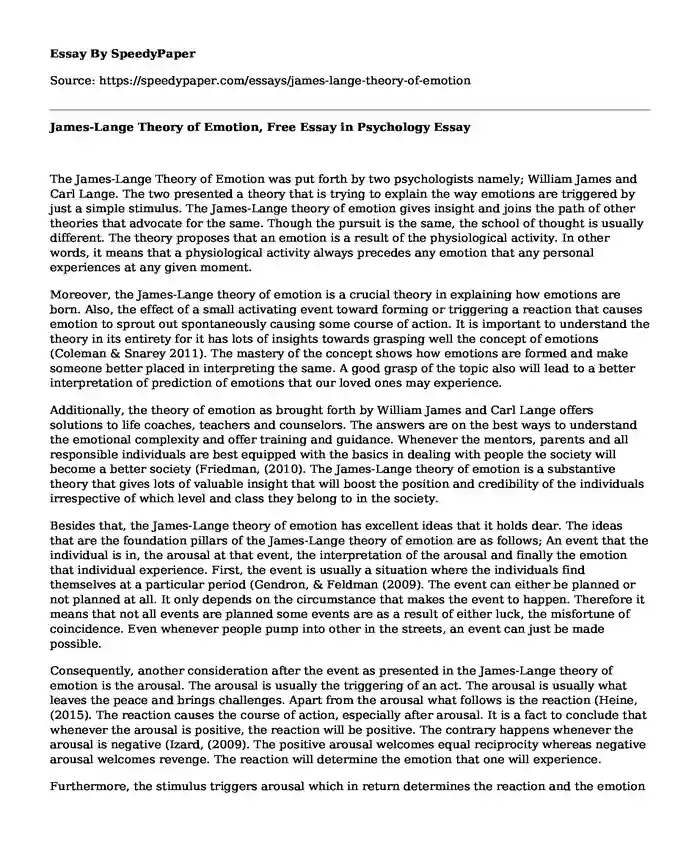
| Type of paper: | Essay |
| Categories: | Psychology |
| Pages: | 3 |
| Wordcount: | 743 words |
The James-Lange Theory of Emotion was put forth by two psychologists namely; William James and Carl Lange. The two presented a theory that is trying to explain the way emotions are triggered by just a simple stimulus. The James-Lange theory of emotion gives insight and joins the path of other theories that advocate for the same. Though the pursuit is the same, the school of thought is usually different. The theory proposes that an emotion is a result of the physiological activity. In other words, it means that a physiological activity always precedes any emotion that any personal experiences at any given moment.
Moreover, the James-Lange theory of emotion is a crucial theory in explaining how emotions are born. Also, the effect of a small activating event toward forming or triggering a reaction that causes emotion to sprout out spontaneously causing some course of action. It is important to understand the theory in its entirety for it has lots of insights towards grasping well the concept of emotions (Coleman & Snarey 2011). The mastery of the concept shows how emotions are formed and make someone better placed in interpreting the same. A good grasp of the topic also will lead to a better interpretation of prediction of emotions that our loved ones may experience.
Additionally, the theory of emotion as brought forth by William James and Carl Lange offers solutions to life coaches, teachers and counselors. The answers are on the best ways to understand the emotional complexity and offer training and guidance. Whenever the mentors, parents and all responsible individuals are best equipped with the basics in dealing with people the society will become a better society (Friedman, (2010). The James-Lange theory of emotion is a substantive theory that gives lots of valuable insight that will boost the position and credibility of the individuals irrespective of which level and class they belong to in the society.
Besides that, the James-Lange theory of emotion has excellent ideas that it holds dear. The ideas that are the foundation pillars of the James-Lange theory of emotion are as follows; An event that the individual is in, the arousal at that event, the interpretation of the arousal and finally the emotion that individual experience. First, the event is usually a situation where the individuals find themselves at a particular period (Gendron, & Feldman (2009). The event can either be planned or not planned at all. It only depends on the circumstance that makes the event to happen. Therefore it means that not all events are planned some events are as a result of either luck, the misfortune of coincidence. Even whenever people pump into other in the streets, an event can just be made possible.
Consequently, another consideration after the event as presented in the James-Lange theory of emotion is the arousal. The arousal is usually the triggering of an act. The arousal is usually what leaves the peace and brings challenges. Apart from the arousal what follows is the reaction (Heine, (2015). The reaction causes the course of action, especially after arousal. It is a fact to conclude that whenever the arousal is positive, the reaction will be positive. The contrary happens whenever the arousal is negative (Izard, (2009). The positive arousal welcomes equal reciprocity whereas negative arousal welcomes revenge. The reaction will determine the emotion that one will experience.
Furthermore, the stimulus triggers arousal which in return determines the reaction and the emotion respectively. For example, just from a German shepherd dog barking in the neighborhood several things will happen one after another. First, it is critical to note that the activating event in this scenario is the barking dog. The physiological reaction will be as follows; increased heart rate, sweating and even fast breathing. The physiological reactions will result in either anxiety or fear as the emotional response.
References
Coleman, A. E., & Snarey, J. (2011). James-Lange Theory of Emotion. In Encyclopedia of Child Behavior and Development(pp. 844-846). Springer US.
Friedman, B. H. (2010). Feelings and the body: the Jamesian perspective on autonomic specificity of emotion. Biological psychology, 84(3), 383-393.
Gendron, M., & Feldman Barrett, L. (2009). Reconstructing the past: A century of ideas about emotion in psychology. Emotion review, 1(4), 316-339. Friedman, B. H. (2010). Feelings and the body: the Jamesian perspective on autonomic specificity of emotion. Biological psychology, 84(3), 383-393.
Heine, S. J. (2015). Cultural psychology: Third International Student Edition. WW Norton & Company.
Izard, C. E. (2009). Emotion theory and research: Highlights, unanswered questions, and emerging issues. Annual review of psychology, 60, 1-25.
Cite this page
James-Lange Theory of Emotion, Free Essay in Psychology. (2022, May 19). Retrieved from https://speedypaper.net/essays/james-lange-theory-of-emotion
Request Removal
If you are the original author of this essay and no longer wish to have it published on the SpeedyPaper website, please click below to request its removal:
- Critically analyze the films, references to social and historical contexts
- Generalized Anxiety Disorder: The Case of Alice, Free Essay
- Political Parties: Party Politics at The Grassroots, Essay Example
- Lesson Plan Essay Example
- Essay Sample on Pre-Existing Conditions in Obamacare
- Essay Sample on Social Actions
- Paper Example on Pregnant Woman Abuse
Popular categories




